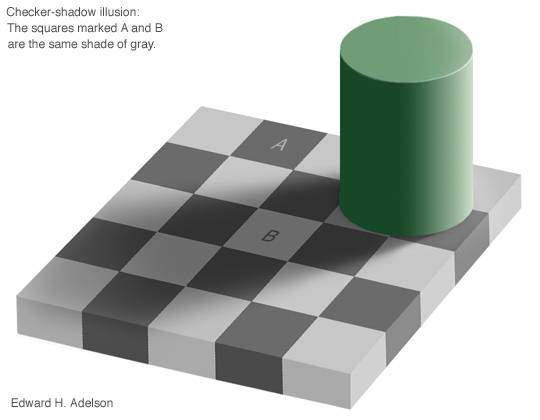Coming Down the Pipeline: Infinite Image Engine
I’ve always been fascinated by how our minds perceive visual data (may I call that the MGPU for Mental Graphical Processing Unit? *cough*geek*cough*). What I find interesting is that what we see, mostly, is not an accurate reflection of reality. It is simply how our mind filters and manipulates the data it is presented with. Even when we are aware of exactly how we are being misled by misinterpreted visual data we still are not able to force our minds to interpret it correctly.
Case in point is this optical illusion:

Believe it or not the tiles marked A and B are exactly the same color. It’s impossible to see in this visual context, but take a piece of paper and cover up everything except those two squares and it becomes obvious.
One piece of optical tomfoolery we rely on everyday is the lowly pixel. A pixel is the smallest unit of measure on an LCD or CRT display. Pixels allow us to be fooled into seeing a color that isn’t really there by taking three phosphors, one red, one blue, one green, and manipulating them. Our eyes see a whole range of colors..even though the image is only made up of red, blue, and green phosphors. That’s the faulty wiring in our MGPU.
This rather long segway is an introduction to my current project: the Infinite Image Engine. You may have seen the coffee table books that have well-known, easily recognizable pictures that have been manipulated so that each image is made up of hundreds or even thousands of smaller pictures. If you look at it closely, all you see are a random group of images. If you look at it from a distance, you will see the larger image.
The Infinite Image Framework gets its name from the fact that it is possible to zoom infinitely on any image. As you zoom closer the image is resolved into smaller images. As you zoom into the smaller images these are comprised of yet smaller images, ad infinitum.
The framework I am designing will allow you to select an image and have that image be transformed into a collage of smaller images while still being recognizably the same. In its current testing incarnation you can choose keywords for the types of images you want to have included. The images will be pulled off of flickr and matched as appropriate.
The tricky parts of the framework are done and I’m just hammering out the tweaks that will allow maximum flexibility.
I will hopefully have some screenshots posted in the next few days and some apps/code posted shortly thereafter.
Cheers!
Michael G. Emmons
October 18th, 2006 at 4:40 am
Hello
I pasted the picture in paint and the colors are different.
A=(112,112,112)
B=(107,107,107)
Can you confirm?
October 25th, 2006 at 7:13 pm
I get 108 and 107 in photoshop. The slight differences is due to JPG compression. The original image didn’t have the same issue, but is too large to post. In any case, the slight difference you see is not detectible and what is really interesting is if you copy A and paste it in B it still looks like it is a different color.